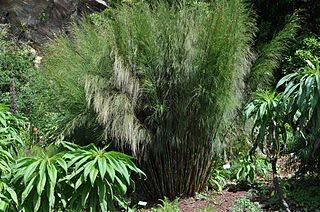Related Research Articles

The Cyperaceae are a family of graminoid (grass-like), monocotyledonous flowering plants known as sedges. The family is large; botanists have described some 5,500 known species in about 90 genera – the largest being the "true sedges", with over 2,000 species.

The Restionaceae, also called restiads and restios, are a family of flowering plants native to the Southern Hemisphere; they vary from a few centimeters to 3 meters in height. Following the APG IV (2016): the family now includes the former families Anarthriaceae, Centrolepidaceae and Lyginiaceae, and as such includes 51 genera with 572 known species. Based on evidence from fossil pollen, the Restionaceae likely originated more than 65 million years ago during the Late Cretaceous period, when the southern continents were still part of Gondwana.

Cannomois is a group of plants in the Restionaceae described as a genus in 1828. The entire genus is endemic to Cape Province in South Africa.

Tetraria is a genus of flowering plants in the sedge family, Cyperaceae, native to Tanzania, South Africa, Borneo, Australia and New Zealand.

Fuirena, called umbrella sedges or umbrella grasses, are a genus of flowering plants in the sedge family (Cyperaceae), with a worldwide distribution, chiefly in the tropics and temperate zones. They are named for Danish physician and early botanist Georg Fuiren, 1581–1628.
References
- ↑ Angiosperm Phylogeny Group (2009). "An update of the Angiosperm Phylogeny Group classification for the orders and families of flowering plants: APG III". Botanical Journal of the Linnean Society. 161 (2): 105–121. doi: 10.1111/j.1095-8339.2009.00996.x . hdl: 10654/18083 . Archived from the original (PDF) on 25 May 2017. Retrieved 6 July 2013.
- ↑ Doyle, J. A.; Donoghue, M. J. (1986). "Seed plant phylogeny and the origin of the angiosperms - an experimental cladistic approach". Botanical Review. 52 (4): 321–431. doi:10.1007/bf02861082.
- ↑ Butler, Rhett A. (1 July 2019). "Total number of plant species by country". Mongabay. Retrieved 21 July 2019.
- ↑ "Vegetation of South Africa". PlantZAfrica.com. SA National Biodiversity Institute. Retrieved 24 July 2019.
- 1 2 3 4 5 6 7 8 9 10 11 12 13 14 15 16 17 18 19 20 21 22 23 24 25 26 27 28 29 30 31 32 33 34 35 36 37 38 39 40 41 42 43 44 45 46 47 48 49 50 51 52 53 54 55 56 57 58 59 60 61 62 63 64 65 66 67 68 69 70 71 72 73 74 75 76 77 78 79 80 81 82 83 84 85 86 87 88 89 90 91 92 93 94 95 96 97 98 99 100 101 102 103 104 105 106 107 108 109 110 111 112 113 114 115 116 117 118 119 120 121 122 123 124 125 126 127 128 129 130 131 132 133 134 135 136 137 138 139 140 141 142 143 144 145 146 147 148 149 150 151 152 153 154 155 156 157 158 159 160 161 162 163 164 165 166 167 168 169 170 171 172 173 174 175 176 177 178 179 180 181 182 183 184 185 186 187 188 189 190 191 192 193 194 195 196 197 198 199 200 201 202 203 204 205 206 207 208 209 210 211 212 213 214 215 216 217 218 219 220 221 222 223 224 225 226 227 228 229 230 231 232 233 234 235 236 237 238 239 240 241 242 243 244 245 246 247 248 249 250 251 252 253 254 255 256 257 258 259 260 261 262 263 264 265 266 267 268 269 270 271 272 273 274 275 276 277 278 279 280 281 282 283 284 285 286 287 288 289 290 291 "species_checklist_20180710.csv". South African National Biodiversity Institute. Retrieved 27 September 2020.
- ↑ Schoenefeldiella P.M.Peterson. Plants of the World Online . Retrieved 29 May 2024.